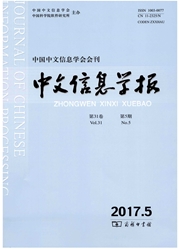

 中文摘要:
中文摘要:
人工智能的最重要内容之一是自然语言处理,建设词汇语义知识库是语言信息处理技术取得进步的重要保障.目前国内外基于同义词群(Synset)的词网研究存在结构不甚严谨,语义颗粒度不够精细,应用范围比较有限的问题.以“词群—词位”变体理论为基础建立多维特征概念语义网(Multi-D WordNet)是对这些问题进行解决的有效尝试,通过分析与描写基本词住(概念本体)与变体之间、变体与变体之间的关系,找出概念属性的差异,从而构建颗粒度更为精细的同义词群.言说动词的次范畴类“交互类”动词可作为研究个案,初步用来探讨这类典型词的语义结构及词群系统的建构规律.
 英文摘要:
英文摘要:
Nature Language Processing (NLP) is one of the most important research parts of artificial intelligence. And the Words Semantic Knowledge Base (WSKB) construction is an important guarantee to make big progress on NLP. Nowadays, the domestic and abroad researches of network of words which based on Synset have several prob- lems: Less stringent structure, rough semantic particle size, limited range of applications and so on. To build up a type of Multi-Dimension Word Net based on the detailed description of the features of concepts may solve these problems. This type of WSKB used the Synset-Lexeme Anamorphosis' Method to analysis the relationship and distinctive features between basis lexeme and its concept anamorphoses. And it introduced the interactive speech act verbs based on characteristic sense analysis as examples, preliminary discuss the description of the lexical meaning structure and its synset construction rules.
 同期刊论文项目
同期刊论文项目
 同项目期刊论文
同项目期刊论文
 期刊信息
期刊信息
